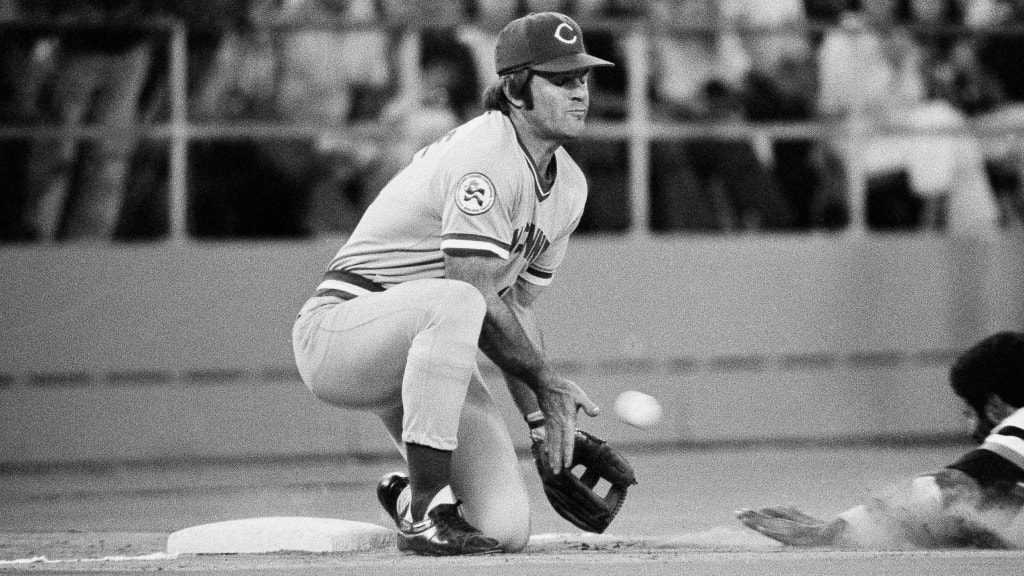
No one loves a good debate quite like baseball fans, and with that in mind, we asked each of our beat reporters to rank the top five players by position in the history of their franchise, based on their career while playing for that club. These rankings are for fun and debate purposes only … if you don’t agree with the order, participate in the Twitter poll to vote for your favorite at this position.
Here is Mark Sheldon’s ranking of the top 5 third basemen in Reds history. Next week: shortstop.
1) Pete Rose, 1963-78, '84-86
Key fact: His 44-game hitting streak in 1978 is third-longest in Major League history
According to the Society for American Baseball Research, Rose played only 18 percent of his games at third base. But that small amount sure proved pivotal, since it came mostly from 1975-78, when Cincinnati’s Big Red Machine won back-to-back World Series in ’75 and ’76. In the years prior, manager Sparky Anderson’s lineup was unsettled at the hot corner. Among those who played there were Tony Perez and Dan Driessen, but both were natural first basemen. Rose’s career began at second base, and he subsequently shifted to right field and left field. Moving Rose to third base in ’75 allowed Anderson to open up left for the power bat of George Foster. The Reds began the ’75 season with a 12-12 record before the switch, and they went 96-42 after.
Rose is one of the greatest to play for the Reds -- and play the game in general. He’s the franchise’s all-time leader in games (2,722), plate appearances (12,344), runs (1,741), hits (3,358), singles (2,490), doubles (601) and walks (1,210). A 17-time All-Star -- including 13 for Cincinnati -- Rose is the Major Leagues’ all-time leader with 4,256 hits. Besides winning two World Series championships with the Reds, and one more with the Phillies, he also claimed the 1963 National League Rookie of the Year Award, the '73 NL Most Valuable Player Award, the '75 World Series MVP Award and three batting titles. He was named a member of MLB’s All-Century team in '99. Because of a lifetime ban in '89 for violating league rules on gambling while managing the Reds, Rose has been ineligible for election to the Hall of Fame. The club was eventually granted permission to induct Rose into its own Hall of Fame in 2016 and retire his No. 14.
2) Heinie Groh, 1913-21
Key fact: His 40.6 career bWAR leads franchise all time at third base
Viewed by SABR as one of the greats of the Deadball Era, Groh made the most of his size -- 5-foot-6, 158 pounds -- to be a superb bunter and leadoff hitter who rarely struck out. He led the NL in walks in 1916 (84), and in ’17, he led the league in hits (182), doubles (39) and on-base percentage (.385).
Groh led the Reds to the 1919 NL pennant and World Series championship while batting .310 with an .823 OPS and 21 steals. Since bunting was a key component of the Deadball Era, his strong fielding skills at third base were considered pivotal in the team’s success.
3) Chris Sabo, 1988-93, '96
Key fact: Inducted into Reds Hall of Fame in 2010
A flat-topped, goggles-wearing throwback of sorts in the 1980s and '90s, Sabo reminded some in Cincinnati of his first big league manager -- Rose -- because of his own hard-nosed style of play.
Sabo was the 1988 NL Rookie of the Year and a three-time All-Star for the Reds. His finest year was helping Cincinnati win the '90 World Series, when he led the club with 25 home runs and 91 runs while driving in 71. He batted .563 with two homers in the ’90 World Series, a four-game sweep of the heavily favored A's.
4) Eugenio Suárez, 2015-21
Key fact: Ranked second in Majors from 2018-19 with 83 home runs -- one behind Mike Trout
A 2018 NL All-Star for Cincinnati, Suárez slugged 49 home runs in '19, tied with Ted Kluszewski in 1954 for second most in a season in club history and second most in MLB by a third baseman. Suárez and Hall of Famer Tony Perez are the only third basemen in club history with at least 25 homers in three seasons and the only two with at least 30 homers in two seasons.
On Dec. 11, 2014, the Reds acquired the then-shortstop Suárez from the Tigers in what proved to be a lopsided trade for pitcher Alfredo Simon. Cincinnati moved Suárez to third base ahead of the ’16 season, and he has the most career homers (168) for that position in franchise history.
5) Todd Frazier, 2011-15
Key fact: Hit a “no-handed” home run in win over Rockies in 2012
Frazier replaced Scott Rolen ahead of the 2013 season, but he didn’t come fully into his own until ’14, when he batted .273/.336/.459 with a team-leading 29 home runs and 80 RBIs in 157 games and went to the first of his back-to-back All-Star Games.
In 2015, Frazier starred for a struggling Reds club and became one of four third basemen in franchise history to slug at least 30 homers in a season. He hit 35 of them, with 89 RBIs, to lead the team. His signature moment came during the '15 All-Star Game festivities at Great American Ball Park, where he won the Home Run Derby on his last swing during the first use of a new timed format.
Honorable mentions
Billy Werber (1939-41) was a key force in back-to-back NL pennant-winning seasons and the 1940 World Series championship. He was inducted into the Reds Hall of Fame in '61.
Aaron Boone (1997-03) played all 162 games in 2002, and he hit 26 home runs with 87 RBIs.
Scott Rolen (2009-12) was a two-time All-Star for Cincinnati at the end of his great career, and he was a leader of the 2010 and ’12 NL Central-winning clubs.


